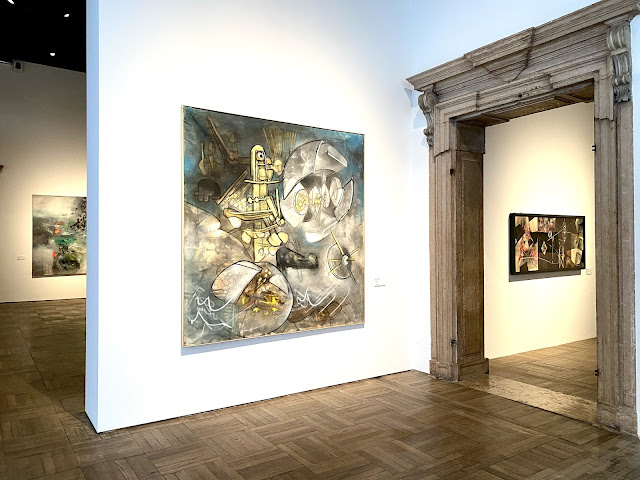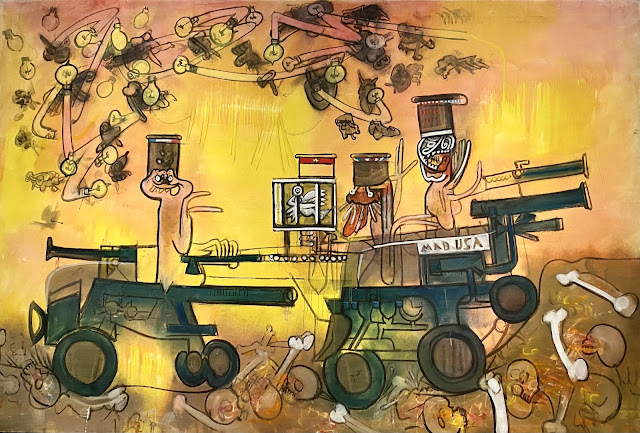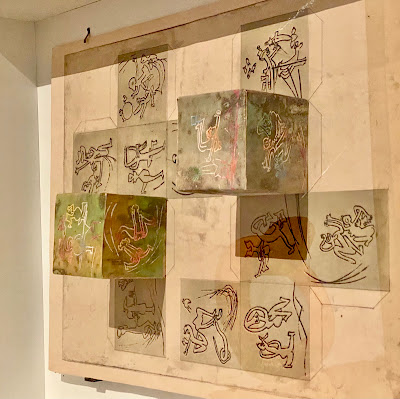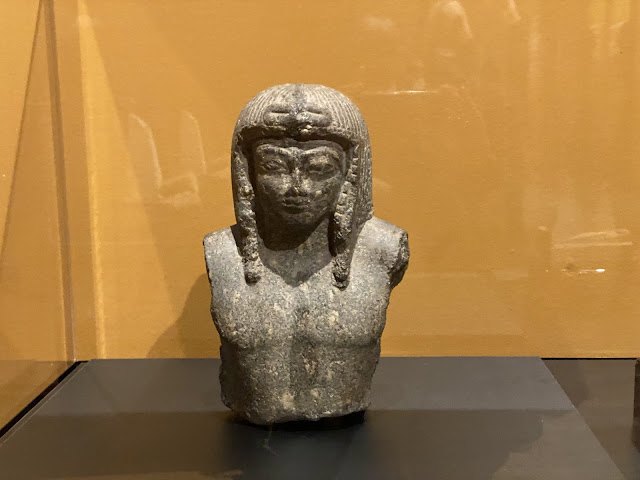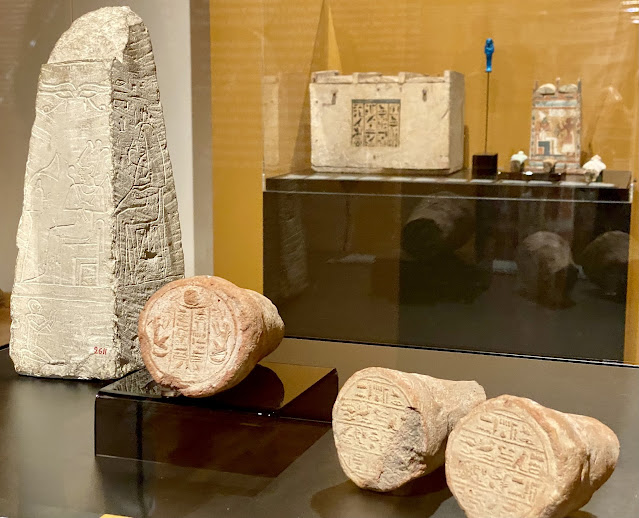"Every individual, every human life, is a bet with a self,
with himself or herself, with the world."
Roberto Matta
Verbal Morphologies - 1986
Ca' Pesaro - Galleria Internazionale d'Arte Moderna
Roberto Matta 1911-2002
The first major Italian exhibition of Chilean artist Roberto Matta - 1911-2002 - until March 23 - is being held at Ca’ Pesaro - curated - Dawn Ades, Elisabetta Barisoni and Norman Rosenthal. The museum highlights Matta’s wide-ranging, visionary work as a painter, draughtsman, architect, sculptor, and activist, blending scientific, cultural, and philosophical ideas. Though a major figure of the 20th century, Matta remains underrepresented in Italian museum collections.
The exhibition begins with Coïgitum - 1972 - above - a monumental 10-meter work showcasing Matta’s experimental approach to space. Blending Surrealist imagery, architectural elements, and non-Euclidean concepts, it reveals his passion for sci-fi and an aesthetic he described as spanning “from Leonardo da Vinci to NASA,” merging video game atmospheres with street art.
pastelli e matita su carta, mm 335 × 500 - Collezione Alisée Matta - courtesy Ca Pesaro
'unusual casual drawings...maltreated nudes,
strange architecture and vegetation.."
Gordon Onslow Ford
Roberto Matta - Gustavo Adolfo - 1939
 olio su tela, cm 95,5 × 122 - Venezia, Ca’ Pesaro- Galleria Internazionale d’Arte Moderna acquisto alla mostra personale presso il
olio su tela, cm 95,5 × 122 - Venezia, Ca’ Pesaro- Galleria Internazionale d’Arte Moderna acquisto alla mostra personale presso il Museo Correr, 1953, inv. 2001 - courtesy Ca Pesaro
The exhibition highlights Matta’s historical ties with Venice. He first visited in 1948 as part of the Peggy Guggenheim collection at the Greek Pavilion. In 1953, the Matta 1949-1953 exhibition at Museo Correr led to Alba sulla terra becoming the first of his works to enter an Italian public collection, purchased by the city of Venice for Ca’ Pesaro.
Robert Matta - Alba sulla Terra - 1952
A citizen of the world, visionary,
multifaceted artist, painter and draughtsman, architect and sculptor, as well as a militant
figure, Roberto Sebastián Antonio Matta Echaurren - Santiago de Chile 1911 -
Civitavecchia - 2002 - is certainly one of the most important artists of the twentieth
century and, at the same time, among the least celebrated and represented figures in
Italian museum collections.
Roberto Matta - Museo Correr - 1953
The Curators
Dawn Ades, Norman Rosenthal and Elisabetta Barisoni
A leading figure of Surrealism, whose centenary is being marked in 2024, Matta developed a unique, complex visual language. His art blends surreal irrationality, the unconscious, and psychic automatism with influences from his time with Le Corbusier in Paris. His mature work features exaggerated perspectives and explorations of the fourth dimension, reflecting his love for poetry and ties to Breton. The exhibition celebrates Matta’s multifaceted creativity through his paintings, drawings, sculptures, architecture, and design.
Les Temoins de l'univers - 1947-1948
Resentir l'objet - 1956
The politically engaged Matta, merged art and politics in the post-war era, influenced by the memory of Federico García Lorca. He passionately supported the early Cuban revolution alongside other artists. Key works at Ca' Pesaro include La Question - 1958 - above - on the Algerian War, the monumental La Chasse aux adolescents reflecting the French May 1968 protests, and El Burundu Burunda ha muerto - 1975 - below - addressing Colombia’s 1950s civil war.
La Question - 1958
Matta, while constantly transgressing the borderline between abstraction and
figuration, he exerted a fundamental influence on the American abstract
expressionists of the 1940s. Above all, Matta"s work immediately presents itself as a
participant in the world of science fiction, as a forerunner of an aesthetic in which the
atmospheres of video games mix with those of street art.
Etre Hommonde - 1960
El ingenioso Hidalgo Don Quijote de la Mancha - 1961
Museros - 1969
Untitled - 1952
Les Juges partent en guerre - 1967
L'espace du point - 1960s
Floricor - 1988
El Burundu Burunda ha muerto - 1975
Les photographes - 2000
Alongside the artworks are contemporary design
objects, such as the - above - Malitte seating system: a modular composition of five blocks, now
produced by Paradisoterrestre and available to the public at the exhibition. There
are also glass sculptures - see above - the offspring of the extraordinary Venetian
experience of the Fucina degli Angeli.
Paradisoterrestre's Gherardo Tonelli

%202.jpg)







